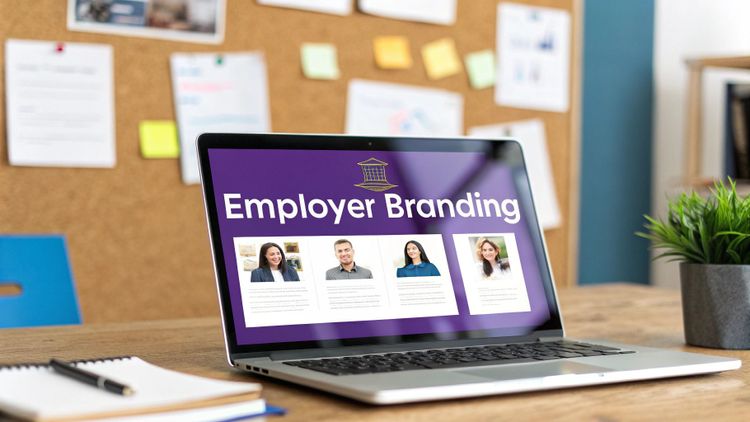Employer Branding
How to Build a Strong Employer Brand and Attract Better Talent

Modern-day job seekers are choosy about where they want to apply for work. They are using all avenues to scrutinise brands before deciding to send in their applications.
So in a competitive hiring environment, your employer brand is crucial.

Why employer branding is important
As a brand that wants to attract high-quality hires, you have to be keen on your employer brand. Here's why:
- Your employer brand is important for attracting more candidates, increasing your hiring options.
- It will also help you attract better quality applicants that ultimately drive results and improve your company culture.
- A strong employer brand can increase morale and retention within the company, helping you keep your best talent for longer.
Your employer brand influences how candidates and current staff perceive you as a company to work for - so it can work for and against your favour.
In this article, we'll highlight our top tips for building a strong employer brand that helps you attract and keep better talent.
How to influence your employer brand
Nowadays, people predominantly use the internet to learn more about companies they are interested in. This means your website and social media pages are key channels that help prospective candidates to determine if they want to work for you or not.
In addition, job review sites such as Glassdoor have become hugely popular platforms where employees can share opinions, salaries and approval levels of your CEO.

However, employer brand goes beyond what is said about your company on the internet. It entails all your efforts to communicate your company culture and the work environment you provide to employees.
This means face-to-face referrals, conversations, and other interactions with your business are all signals of the quality of your employer brand.
6 Ways to Improve Your Employer Brand
So there's an endless list of things you can do to influence your employer brand both positively and negatively. What then should you focus on, assuming limited time and resources?
Let's look at our top tips to build a strong employer brand.
1. Overcommunicate during the application process
Candidates are more attracted to brands with a human face and personality than a highly bureaucratic and faceless corporation.
If you can, call your best candidates and ask if they have any concerns before they come for interviews. You can also chat with them on social media and invite them to participate in online conversations with your staff.
The important thing here is to keep candidates engaged with regular progress updates and showing them you're interested in building a real, human connection upfront.
This approach is also relevant to the way you reject candidates. Communicate your reasons for not picking them and assure them you have their file and may consider them in the future. This will make the experience less painful and they may reapply the next time you have an opening or refer more suitable candidates to you.
An applicant tracking system like SeeMeHired will help you keep candidates in the loop by centralising hiring and communication in one place. Learn more about SeeMeHired.

2. Create an internal feedback loop
If you don't know about an issue or ignore it for too long, people are likely to voice their frustration publicly and harm your employer brand.
So it's important to implement regular employer and management reviews to collect opinions from your team before it's too late to act on them.
This is also a great source of ideas for HR programs that go well beyond employer branding - influencing company culture and overall performance in your company.
Ultimately, employees who feel respected are happier. This bounces back to your organisation through positive reviews, increased productivity, and loyalty.
Take the time to listen to them and see the multiple benefits accumulate over time.
3. Encourage flexibility and work-life balance
Your organisation needs to be guided by clear policies, but you should be flexible in enforcing them. Your business success matters, but so does the success of your employees.
For instance, if you offer flexible working hours and a generous remote work policy, your employees can improve their quality of life. This not only creates a more satisfied workforce that promotes you as an employer, but it's likely to improve productivity overall.
4. Share salary details upfront
Candidates can usually check with a high degree of accuracy what's the approximate pay range at your company for a given role. Both Glassdoor and LinkedIn Salary contain lots of data on average compensation across industries, locations, and positions.
So keeping this information private until the interview stage is not contributing a lot if you want to negotiate salary levels. Rather, it creates an impression that you pay less than average and repels good candidates.
Even if you can't afford to pay top-of-the-range salaries, you can add a pay scale (from X to Y) depending on experience in the job description. This will ensure highly qualified candidates will at least apply and interact with your business, allowing you to win them over with other perks.
5. Get involved in managing your online presence
Your website and social media accounts are key HR channels so don't leave them to IT or marketing alone.
Get involved and make sure your employer brand is highlighted across platforms like LinkedIn and your careers pages.
Here are a few areas you should pay special attention to:
- About/Careers pages: show video testimonials from current employees, highlight your company values and present the range of benefits you can offer as an employer.
- LinkedIn: This is likely one of your key responsibilities already - make sure you are aligned with sales and marketing in regards to the use of LinkedIn so you create a focused brand image on the platform. If you use it for hiring, your page should mostly contain updates around new roles, new hires, and other HR-related news instead of marketing messages.
- Instagram: share fun photos and experiences with your team.
- Tone and copywriting: get involved in building a friendly and enthusiastic brand personality through the content and copywriting you use across different channels - even if this is not your main responsibility.
- Design: visuals create a quick and lasting impression so make sure your management team understands the value of great design for building an employer brand.
- PR: news websites will often show up higher in search results than your own so keep an eye on anything that could harm or improve your brand.
As you can see, there are many areas that typically fall under someone else's job description but are crucial to your success as a recruiter. This is why you should take the time and connect with relevant team members or work with outside professionals to enhance your HR efforts.
6. Push a consistent message across all channels
This is one of the most important points in this article - effective employer branding requires consistency and repetition.
There are two stages here:
- Decide what your employer brand stands for
- Stand for it all the time and across channels
So think deeply about your main advantage as an employer and what your prospective candidates are looking for. The intersection between them will become your main employer brand message.
Once you have this message, drive it consistently across your website, social channels, and internal communication.
Conclusion
A strong employer brand will help you attract, hire, and retain great talent even if when the competition is high.
However, employer branding can also harm your chances of success when ignored or executed poorly.
This is why you should pay special attention to this business area and do everything in your power to influence it.
While online channels dominate how candidates acquire information nowadays, you should try to build your employer reputation across other key areas like your internal communication and overall culture.
Most importantly, discover your key advantage as an employer and share it widely and consistently.
The result of all this will be a strong employer brand valued by your team and external stakeholders for a long time to come.




